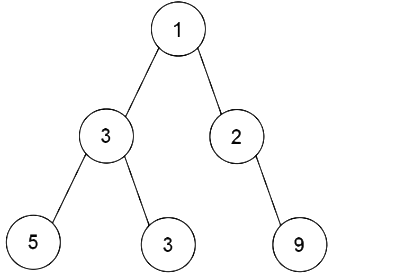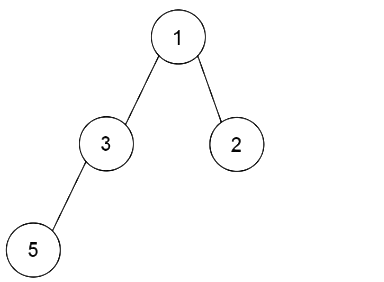[字节二面算法] 662. 二叉树最大宽度
给你一棵二叉树的根节点 root ,返回树的 最大宽度 。
树的 最大宽度 是所有层中最大的 宽度 。
每一层的 宽度 被定义为该层最左和最右的非空节点(即,两个端点)之间的长度。将这个二叉树视作与满二叉树结构相同,两端点间会出现一些延伸到这一层的 null 节点,这些 null 节点也计入长度。
题目数据保证答案将会在 32 位 带符号整数范围内。
示例 1:

输入:root = [1,3,2,5,3,null,9]
输出:4
解释:最大宽度出现在树的第 3 层,宽度为 4 (5,3,null,9) 。
示例 2:
输入:root = [1,3,2,5,null,null,9,6,null,7]
输出:7
解释:最大宽度出现在树的第 4 层,宽度为 7 (6,null,null,null,null,null,7) 。
示例 3:

输入:root = [1,3,2,5]
输出:2
解释:最大宽度出现在树的第 2 层,宽度为 2 (3,2) 。
提示:
- 树中节点的数目范围是
[1, 3000] -100 <= Node.val <= 100
暴力模拟空节点(超时
class Solution {
public int widthOfBinaryTree(TreeNode root) {
var ans = 0;
if (root == null) {
return ans;
}
Queue<TreeNode> queue = new LinkedList<>();
queue.add(root);
while (!queue.isEmpty()) {
var count = queue.size();
var widthCount = 0;
var nullCount = 0;
boolean flag = false;
while(count-- > 0) {
TreeNode poll = queue.poll();
if(poll != null) {
System.out.print(poll.val + " ");
flag = true;
queue.add(poll.left);
queue.add(poll.right);
widthCount += nullCount + 1;
nullCount = 0;
} else {
System.out.print("* ");
queue.add(null);
queue.add(null);
if(widthCount > 0) {
nullCount++;
}
}
}
System.out.println();
if(!flag) {
break;
}
ans = Math.max(widthCount, ans);
}
return ans;
}
}
利用层序遍历的性质
记录节点的编号,然后用同一层的最大节点编号减去最小然后+1就是该层的最大宽度了。
class Solution {
public int widthOfBinaryTree(TreeNode root) {
var ans = 0;
if (root == null) {
return ans;
}
Queue<TreeNode> queue = new LinkedList<>();
queue.add(root);
Map<TreeNode, Long> map = new HashMap<>();
map.put(root, 1L);
while (!queue.isEmpty()) {
var count = queue.size();
var min = Long.MAX_VALUE;
var max = Long.MIN_VALUE;
while(count-- > 0) {
TreeNode poll = queue.poll();
var cur = map.get(poll);
min = Math.min(min, cur);
max = Math.max(max, cur);
if(poll.left != null) {
queue.add(poll.left);
map.put(poll.left, cur * 2);
}
if(poll.right != null) {
queue.add(poll.right);
map.put(poll.right, cur * 2 + 1);
}
}
ans = (int) Math.max(ans, max - min + 1);
}
return ans;
}
}
原来可以这么写。。
和上面的思路是一样的,这题并不难,其实最开始也想到用编号的方法,但是想着给的树节点定义是改变不了的,所以模拟超时之后又想到了使用map,然后看到别人其实是直接定义一个新类嵌套了树节点,这样的话就省去了map集合的操作时间消耗,学到了学到了
/**
* Definition for a binary tree node.
* public class TreeNode {
* int val;
* TreeNode left;
* TreeNode right;
* TreeNode() {}
* TreeNode(int val) { this.val = val; }
* TreeNode(int val, TreeNode left, TreeNode right) {
* this.val = val;
* this.left = left;
* this.right = right;
* }
* }
*/
class Solution {
public class QueueNode {
TreeNode root;
long index;
QueueNode(TreeNode root, long index) {
this.root = root;
this.index = index;
}
}
public int widthOfBinaryTree(TreeNode root) {
if (root == null) {
return 0;
}
var ans = 1;
Queue<QueueNode> queue = new LinkedList<>();
queue.add(new QueueNode(root, ans));
while(!queue.isEmpty()) {
var size = queue.size();
var first = 0L;
var last = 0L;
for(var i = 0; i < size; i++) {
QueueNode poll = queue.poll();
var index = poll.index;
if(i == 0) {
first = index;
// 注意这里
last = index;
} else if (i == size - 1 ){
last = index;
}
var left = poll.root.left;
var right = poll.root.right;
if(left != null) {
queue.add(new QueueNode(left, index * 2));
}
if(right != null) {
queue.add(new QueueNode(right, index * 2 + 1));
}
}
ans = (int) Math.max(ans, last - first + 1);
}
return ans;
}
}